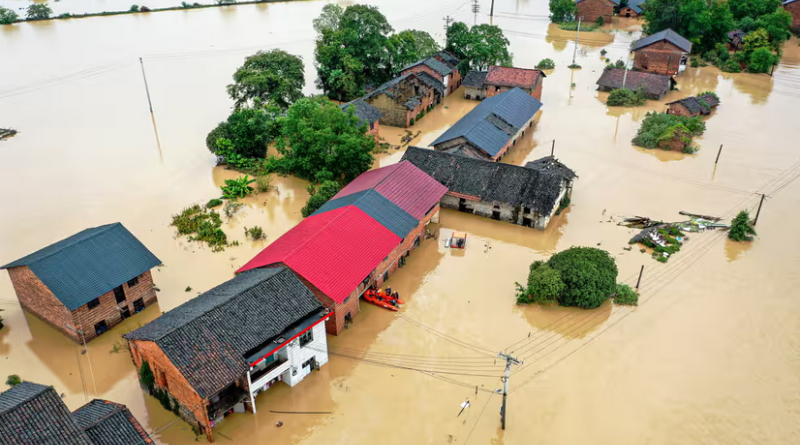China sees highest number of significant floods since records began

This aerial photo taken on 28 July shows a flood-affected village following heavy rains caused by typhoon Gaemi in Zixing, in central China's Hunan province. Photograph: AFP/Getty Images
Halfway through the peak flood season, China has already experienced the highest number of significant floods since record keeping began in 1998, and the hottest July since 1961, authorities said on Friday.
This year so far it has recorded 25 “numbered” events, which the Chinese Ministry of Water Resources defined as having water levels that prompt an official warning or are measured at a magnitude of a “once in two to five years” event.
At a press conference this week, authorities said 3,683 river flood warnings and 81 mountain flood disaster warnings had been issued, state media reported. Almost 5,000 reservoirs had been put into operation diverting 99bn litres of floodwaterto prevent the relocation of more than 6.5 million people.
China has been hit by wild weather this summer, including heatwaves, drought, an early start to the annual flood season, and the remnants of typhoon Gaemi which brought floods and destruction to the Philippines and Taiwan before reaching China’s east coast. Dozens of people have been killed and hundreds of thousands have been forced to evacuate after floods and landslides across several provinces. Thousands of homes have been damaged and crops and livestock wiped out.
On Thursday, state media said Gaemi had killed at least 30 people in Hunan, with about 35 others still missing.
The national meteorological administration said the climate had “deviated from the norm” in China this year, driving the natural disasters. The national rainfall average was 13.3% higher than average, with 30 weather stations recording record highs. Four major rivers received above average rain. The Huaihe river and the Liaohe river basins received double the average.
China is the world’s largest producer of carbon emissions, which are driving the climate crisis. It has pledged to peak emissions by 2030 and bring them to a net zero by 2060, with ambitious state-backed renewables projects. Research released last month showed that China is building almost twice as much wind and solar energy capacity than every other country combined.
The national weather office also said last month was the hottest July since observations began in 1961, and “the hottest single month in the history of observation”. The average July air temperature was 23.21 degrees Celsius, exceeding the previous record set in 2017 of 23.17C, and every province in China reported a mean temperature in July higher than average for previous years.
High temperatures and rainfall in China were expected to continue in the next 10 days, with a red alert for extreme heat, up to 40C, issued for Shanghai on Friday. Hangzhou could potentially reach 43C, authorities said. The typhoon season also continues through August.





